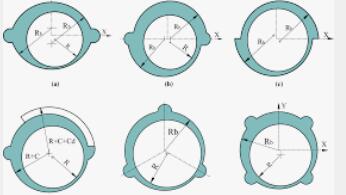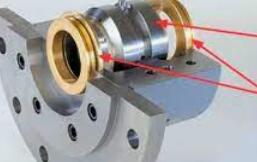The Benefits of Using Journal Bearings
Unlock the Power of Journal Bearings: Discover their high load capacity, low friction, self-lubrication, and more. Optimize your machinery's performance now!
Journal bearings are essential components in various industries, playing a crucial role in supporting rotating machinery and reducing friction between moving parts.
Their unique design and properties offer a range of benefits that contribute to improved performance, efficiency, and durability.
Advantages of using journal bearings:
1.High load capacity
2.Low friction
3.Self-lubricating
4.Reduced vibration and noise
5.Long service life
In this article, we will explore the advantages of using journal bearings, from their high load capacity and low friction to their self-lubricating nature and long service life.
Discover how these bearings can optimize machinery operation and enhance overall productivity.
What are Journal Bearings?

Journal bearings are a type of plain bearing that play a crucial role in supporting rotating machinery and reducing friction between moving parts.
They consist of a shaft, known as the journal, and a bearing surface.
The journal rotates within the bearing surface, creating a fluid film of lubrication between them to facilitate smooth operation.
Types of Journal Bearings

There are several types of journal bearings available, each designed to suit different applications and operating conditions.
The three most common types are hydrodynamic journal bearings, hydrostatic journal bearings, and Babbitt-lined journal bearings.
Hydrodynamic Journal Bearings
Hydrodynamic journal bearings rely on the rotation of the journal to generate a hydrodynamic wedge of lubricant between the journal and the bearing surface.
This fluid film prevents direct contact between the surfaces, reducing friction and wear.
These bearings are highly efficient and cost-effective, making them widely used in various applications.
Hydrostatic Journal Bearings
Hydrostatic journal bearings differ from hydrodynamic bearings in that they use an external pump to supply pressurized lubricant to the bearing surface.
This pressurized lubrication creates a fluid film that separates the journal from the bearing.
The use of pressurized lubrication enhances the load-carrying capacity of the bearing and provides greater control over its performance characteristics.
Hydrostatic journal bearings are commonly found in high-speed machinery and precision applications.
Babbitt-lined Journal Bearings
Babbitt-lined journal bearings have a thin layer of Babbitt material, a soft and low-friction alloy, on the bearing surface.
This lining offers excellent wear resistance and reduces friction between the journal and the bearing.
Babbitt-lined journal bearings are frequently used in large industrial equipment and heavy machinery where high loads and durability are required.
Advantages of Using Journal Bearings

Journal bearings offer numerous advantages over other bearing types, making them a popular choice in various industries. The key benefits include:
High Load Capacity
Journal bearings have a high load-carrying capacity due to the hydrodynamic or hydrostatic film of lubrication.
The fluid film supports and distributes the load, allowing the bearings to withstand heavy machinery loads and significant radial and axial forces.
Low Friction
The presence of a fluid film of lubrication in journal bearings reduces friction between the rotating journal and the bearing surface.
This low-friction characteristic minimizes wear and energy losses, leading to improved overall machinery efficiency and reduced power consumption.
Self-Lubricating
One of the notable advantages of journal bearings is their self-lubricating nature.
The rotation of the journal generates the necessary hydrodynamic or hydrostatic pressure to create and maintain the lubricating film between the surfaces
. This self-lubrication eliminates the need for additional lubricants and simplifies maintenance requirements.
Reduced Vibration and Noise
The fluid film of lubrication in journal bearings acts as a cushion, dampening vibrations and reducing noise.
By minimizing vibrations, journal bearings contribute to smoother operation, improved performance, and enhanced overall comfort in various applications.
Long Service Life
With proper maintenance and operating conditions, journal bearings can have a long service life.
The self-lubricating design and reduced wear due to low friction contribute to their longevity.
Additionally, advancements in bearing materials and manufacturing processes have further increased their durability and reliability.
Applications of Journal Bearings
Journal bearings find extensive applications across various industries due to their beneficial characteristics. Some of the common applications include:
Turbines and Generators
Journal bearings are used in turbines and generators to support the rotating shafts.
The high load capacity and self-lubricating nature of journal bearings ensure reliable and efficient operation in power generation plants.
Pumps and Compressors
Journal bearings are widely employed in pumps and compressors to facilitate smooth rotation and reduce friction.
The low-friction properties of journal bearings help minimize energy losses and extend the equipment's lifespan.
Automotive Engines
Journal bearings are essential components in automotive engines, supporting various parts such as crankshafts, camshafts, and connecting rods.
The self-lubricating and high-load capacity attributes of these bearings enhance the performance and longevity of the engine, contributing to smoother operation and improved fuel efficiency.
Industrial Equipment
Journal bearings are extensively used in industrial equipment, including gearboxes, conveyors, and rotating machinery.
Their ability to withstand heavy loads and reduce friction ensures reliable and efficient operation of these critical systems.
Conclusion
In conclusion, journal bearings offer numerous benefits, including high load capacity, low friction, self-lubrication, reduced vibration and noise, and long service life.
These advantages make them a preferred choice in various applications ranging from power generation to automotive and industrial machinery.
The continuous advancements in bearing technology further enhance their performance and reliability,
making journal bearings indispensable components in supporting rotating machinery and ensuring smooth operation.





